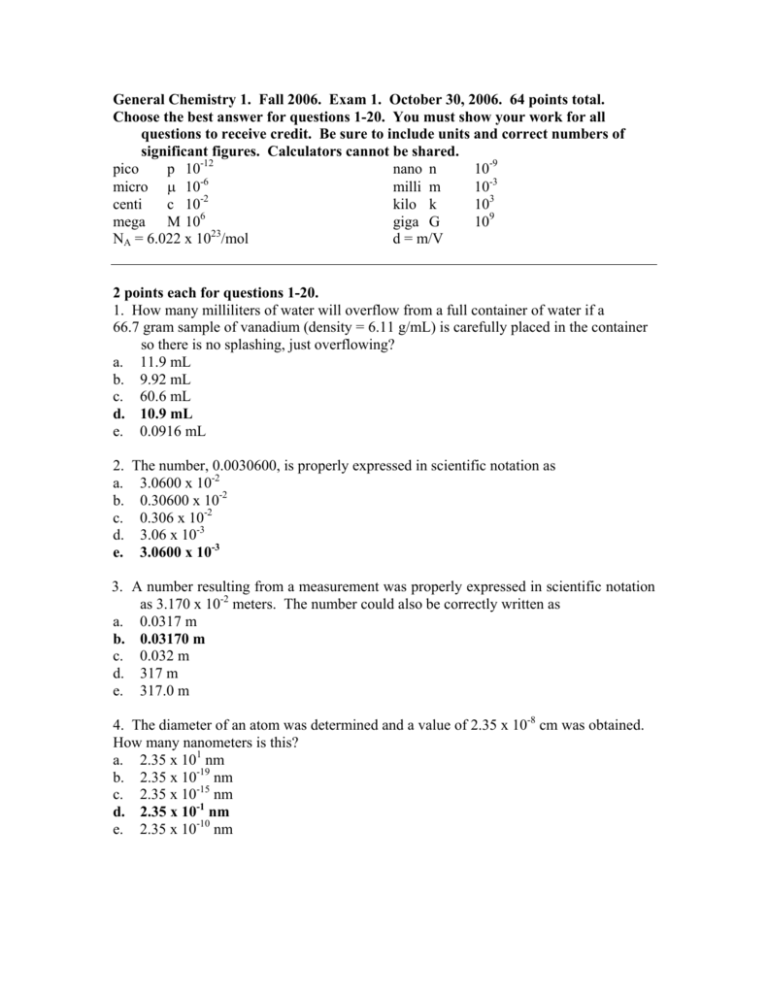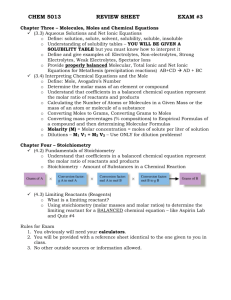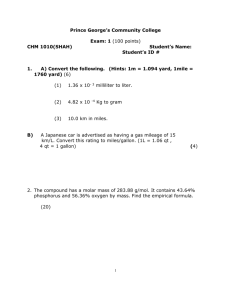General Chemistry 1. Fall 2006. Exam 1. October 30, 2006. 64
advertisement

General Chemistry 1. Fall 2006. Exam 1. October 30, 2006. 64 points total. Choose the best answer for questions 1-20. You must show your work for all questions to receive credit. Be sure to include units and correct numbers of significant figures. Calculators cannot be shared. nano n 10-9 pico p 10-12 -6 micro µ 10 milli m 10-3 centi c 10-2 kilo k 103 6 mega M 10 giga G 109 NA = 6.022 x 1023/mol d = m/V 2 points each for questions 1-20. 1. How many milliliters of water will overflow from a full container of water if a 66.7 gram sample of vanadium (density = 6.11 g/mL) is carefully placed in the container so there is no splashing, just overflowing? a. 11.9 mL b. 9.92 mL c. 60.6 mL d. 10.9 mL e. 0.0916 mL 2. The number, 0.0030600, is properly expressed in scientific notation as a. 3.0600 x 10-2 b. 0.30600 x 10-2 c. 0.306 x 10-2 d. 3.06 x 10-3 e. 3.0600 x 10-3 3. A number resulting from a measurement was properly expressed in scientific notation as 3.170 x 10-2 meters. The number could also be correctly written as a. 0.0317 m b. 0.03170 m c. 0.032 m d. 317 m e. 317.0 m 4. The diameter of an atom was determined and a value of 2.35 x 10-8 cm was obtained. How many nanometers is this? a. 2.35 x 101 nm b. 2.35 x 10-19 nm c. 2.35 x 10-15 nm d. 2.35 x 10-1 nm e. 2.35 x 10-10 nm 5. The atomic mass of chromium is 51.996 g. How many moles of Cr are there in a 5.44 g sample of chromium? a. 0.0875 moles b. 0.0907 moles c. 0.105 moles d. 0.220 moles e. 2.33 moles 6. What is the mass of a phosphorus sample which contains 0.585 moles of phosphorus atoms? a. 17.3 g b. 18.1 g c. 22.3 g d. 26.5 g e. 34.2 g 7. a. b. c. d. e. The molar mass of Ni(H2O)6Cl2 is 157.69 g 193.00 g 227.61 g 237.69 g 296.83 g 8. How many moles of carbon atoms are combined with 11.2 moles of hydrogen atoms in a sample of the compound, C3H8? a. 3.00 b. 5.60 c. 4.20 d. 6.02 x 1023 e. 29.9 9. What is the percent, by mass, of chromium in K2CrO4, to the proper number of significant digits? a. 26.776 % b. 31.763 % c. 40.268 % d. 42.241 % e. 51.996 % 10. Magnetite is a binary compound containing only iron and oxygen. The percent, by weight, of iron is 72.360 %. What is the empirical formula of magnetite? a. FeO b. FeO2 c. Fe3O4 d. Fe2O3 e. Fe2O5 11. A compound has an empirical formula CH2. An independent analysis gave a value of 70 for its molar mass. What is the correct molecular formula? a. C2H4 b. C3H6 c. C4O8 d. C5H10 e. C5H11 12. Given the balanced chemical equation, C4H4 + 5 O2 → 4 CO2 + 2 H2O. If 0.3618 moles of C4H4 are allowed to react with 1.818 moles of O2, and this is the only reaction which occurs, what is the maximum quantity of carbon dioxide that could be produced? a. 1.447 moles b. 1.454 moles c. 1.456 moles d. 2.180 moles e. 0.3978 moles 13. Given the balanced chemical equation, C4H4 + 5 O2 → 4 CO2 + 2 H2O. If 0.3618 moles of C4H4 are allowed to react with 1.818 moles of O2, and this is the only reaction which occurs, what is the maximum quantity of water that could be produced? a. 11.02 g b. 13.04 g c. 13.20 g d. 19.64 g e. 65.50 g 14. a. b. c. d. e. An acid-base neutralization is the reaction of H2(g) with O2(g) to form H2O(l) H2(aq) with OH-(aq) to form H2O(l) H+(aq) with O2(g) to form H2O(l) H+(aq) with OH-(aq) to form H2O(l) Na+(aq) with OH-(aq) to form NaOH(aq) 15. The equation for the reaction, Pb(NO3)2(aq) + NaCl(aq) → PbCl2(s) + NaNO3(aq) can be written as an ionic equation. In this ionic equation, the spectator ions are a. Na+ and Pb2+ b. Na+ and Clc. Pb2+ and Cld. Pb2+ and NO3e. Na+ and NO3- 16. Which one of the following compounds produces 4 ions per formula unit by dissociation when dissolved in water? a. K2C2O4 b. Al(NO3)3 c. Hg2(NO3)2 d. NaBrO3 e. Na2S2O3 17. 66.7 mL of 18.0 molar sulfuric acid solution was dissolved in enough water to make 500 mL of solution. The molarity of the diluted mixture is a. 36.0 molar b. 0.135 molar c. 2.40 molar d. 9.00 molar e. 0.00741 molar 18. Potassium nitrate, KNO3, has a formula weight of 101.10. What is the molar concentration of a solution prepared by dissolving 7.58 grams of potassium nitrate in enough water to prepare 250 mL of the solution? a. 0.0937 molar b. 0.300 molar c. 1.895 molar d. 3.065 molar e. 3.34 molar 19. a. b. c. d. e. What is the oxidation number of each sulfur atom in the S2O82- ion? -2 +1 +3 +5 +7 20. In a chemical reaction, zinc metal reacts with nitric acid solution to produce zinc nitrate(in solution), ammonium nitrate (in solution), and water. The species being oxidized in this reaction is a. HNO3(aq) b. NH4+(aq) c. Zn2+(aq) d. Zn(s) e. Zn(NO3)2(aq) END PART 1. BEGIN PART 2 ON THE NEXT PAGE. Part 2: Answer all questions and show your work. 1. 6 points. Balance the following reaction in acidic solution. HNO2(aq) + MnO4-(aq) → Mn+2(aq) + NO3-(aq) H+ + 2MnO4- + 5HNO2→ 5NO3- + 2Mn+2 + 3H2O 2. 6 points. Consider the following reaction: Pb(NO3)2(aq) + 2KOH(aq) → Pb(OH)2(s) + 2KNO3(aq) Suppose that 2.500 g of each reactant is added together. Calculate the number of grams of the KNO3 that will be produced. Then identify the Limiting Reagent and the Excess Reagent. 0.0151 mol KNO3 from Pb(NO3)3 so the lead nitrate is the limiting reagent 0.0446 mol KNO3 from KOH so the KOH is the excess reagent mass of KNO3 = 1.527 g from 0.0151 mol 3. 6 points. A titration between KOH and a solution of HC2H3O2 takes place. The concentration of KOH is 0.1005 M and 23.05 mL is required to fully neutralize the acetic acid. If 25.00 mL of acetic acid solution is used calculate the mass percent of the acetic acid solution. The density of the acetic acid solution is 1.02 g/mL. mass solute mass = x100 mass solution 4. 6 points. Consider the following reaction. Write the balanced (a) molecular, (b) complete ionic, (c) net ionic equations. Be sure to include states of matter. Co(NO3)3(aq) + KOH(aq) → Molecular: Co(NO3)3(aq) + 3KOH(aq) → Co(OH)3(s) + 3KNO3(aq) Complete ionic: Co+3(aq) + 3NO3-(aq) + 3K+(aq) + 3OH-(aq) → Co(OH)3(s) + 3K+(aq) + 3NO3-(aq) Net ionic: Co+3(aq) + 3OH-(aq) → Co(OH)3(s)





